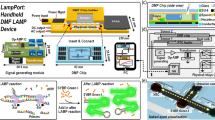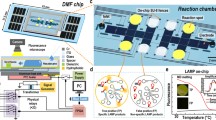Abstract
Digital Microfluidics (DMF) has potentially been a favorable platform for point-of-care molecular diagnostics. However, its fabrication process normally relies heavily on expensive microfabrication facilities and equipment. In this work, we developed a portable, small footprint DMF device that requires minimal microfabrication work (only a small clean bench and a DIY spin coater were required) but is still capable of performing nucleic acid amplification tests. The DMF system implemented in this work could perform successfully the Loop-mediated isothermal Amplification (LAMP) reaction with samples containing extracted DNA of Plasmodium falciparum that causes Malaria in human. The LAMP reaction was conducted at the optimal temperature of 65 °C in 45 min with the total reaction volume of 1.5 µL. The results of LAMP were designed to be observable to naked eyes via the color change from pink to yellowish orange, which simplifies the readout step and eliminates the necessity for external and bulky result-reading equipment.






Similar content being viewed by others
References
AC-DC—OpenDrop (2019). https://www.gaudi.ch/OpenDrop/?p=274. Accessed 29 Sep 2019
Abdelgawad M, Wheeler AR (2007) Rapid prototyping in copper substrates for digital microfluidics. Adv Mater 19(1):133–137
Abdelgawad M, Wheeler AR (2008) Low-cost, rapid-prototyping of digital microfluidics devices. Microfluid Nanofluidics 4(4):349–355
Alistar M, Gaudenz U (2017) OpenDrop: an integrated do-it-yourself platform for personal use of biochips. Bioengineering 4(2):45
Bhattacharjee B, Najjaran H (2010) Droplet position control in digital microfluidic systems. Biomed Microdevices 12(1):115–124
Chang YH, Bin Lee G, Huang FC, Chen YY, Lin JL (2006) Integrated polymerase chain reaction chips utilizing digital microfluidics. Biomed Microdevices 8(3):215–225
Cho SK, Moon H, Kim C-J (2003) Creating, transporting, cutting, and merging liquid droplets by electrowetting-based actuation for digital microfluidic circuits. J Microelectromech Syst 12(1):70–80
Choi K, Ng AHC, Fobel R, Wheeler AR (2012) Digital microfluidics. Annu Rev Anal Chem 5(1):413–440
Coelho B et al (2017a) Digital microfluidics for nucleic acid amplification. Sensors 17(7):1495
Coelho B et al (2017b) A digital microfluidics platform for loop-mediated isothermal amplification detection. Sensors 17(11):2616
de Smith N (2016) Nixie HV switching PSU. https://desmith.net/NMdS/Electronics/NixiePSU.html. Accessed 22 Jan 2018
Fair R (2007) Digital microfluidics: is a true lab-on-a-chip possible? Microfluid Nanofluid 3:245–281
Fobel R, Fobel C, Wheeler AR (2013) DropBot: an open-source digital microfluidic control system with precise control of electrostatic driving force and instantaneous drop velocity measurement. Appl Phys Lett 102(19):1–5
Gong J, Kim C-J (2005) Two dimensional digital microfluidic system by multi-layer printed circuit board. IEEE 11:2693–2700
Gong J, Kim C-J (2008) All-electronic droplet generation on-chip with real-time feedback control for EWOD digital microfluidics. Lab Chip 8(6):898
Supertex Inc (1995) 64-Channel serial to parallel converter with high voltage push-pull outputs. HV507 datasheet, no. DSFP-HV507
Jebrail MJ et al (2011) A digital microfluidic method for dried blood spot analysis. Lab Chip 11(19):3218–3224
Kalsi S et al (2015) Rapid and sensitive detection of antibiotic resistance on a programmable digital microfluidic platform. Lab Chip 15(14):3065–3075
Lau YL, Lai MY, Fong MY, Jelip J, Mahmud R (2016) Loop-mediated isothermal amplification assay for identification of five human plasmodium species in Malaysia. Am J Trop Med Hyg 94(2):336–339
Lebrasseur E et al (2007) Two-dimensional electrostatic actuation of droplets using a single electrode panel and development of disposable plastic film card. Sens Actuators A Phys 136(1):358–366
Li Y, Li H, Baker RJ (2015) A low-cost and high-resolution droplet position detector for an intelligent electrowetting on dielectric device. J Lab Autom 20(6):663–669
Louie M, Louie L, Simor AE (2000) The role of DNA amplification technology in the diagnosis of infectious diseases. CMAJ 163(3):301–309
Manuscript A, Microfluidics DTD, Printed UM, Board C (2009) NIH public access. Vital Health Stat Ser 20 Data From Natl Vitalstatist Syst 17(2):257–264
Murran MA, Najjaran H (2012) Capacitance-based droplet position estimator for digital microfluidic devices. Lab Chip 12(11):2053
Ng AHC et al (2018) A digital microfluidic system for serological immunoassays in remote settings. Sci Transl Med 6076:1–13
Nikapitiya NYJB, Nahar MM, Moon H (2017) Accurate, consistent, and fast droplet splitting and dispensing in electrowetting on dielectric digital microfluidics. Micro Nano Syst Lett 5(1):24
Norian H, Field RM, Kymissis I, Shepard KL (2014) An integrated CMOS quantitative-polymerase-chain-reaction lab-on-chip for point-of-care diagnostics. Lab Chip 14(20):4076–4084
Pollack MG (2001) Electrowetting-based microactuation of droplets for digital microfluidics, pp 1–159
Pollack MG, Fair RB, Shenderov AD (2000) Electrowetting-based actuation of liquid droplets for microfluidic applications. Appl Phys Lett 77(11):1725–1726
Shah GJ, Sadeghi S, Ding H, Chen S, Van Dam RM (2011) Impedance-based droplet volume and concentration, pp 1308–1310
Shih SCCC, Fobel R, Kumar P, Wheeler AR (2011) A feedback control system for high-fidelity digital microfluidics. Lab Chip 11(3):535–540
Srigunapalan S, Eydelnant IA, Simmons CA, Wheeler AR (2012) A digital microfluidic platform for primary cell culture and analysis. Lab Chip 12(2):369–375
Tanner NA, Zhang Y, Evans TC (2015) Visual detection of isothermal nucleic acid amplification using pH-sensitive dyes. Biotechniques 58(2):59–68
Wan L et al (2019) LampPort: a handheld digital microfluidic device for loop-mediated isothermal amplification (LAMP)
Wan L et al (2017) A digital microfluidic system for loop-mediated isothermal amplification and sequence specific pathogen detection. Sci Rep 7(1):1–11
WHO | Antimicrobial resistance (2018) WHO. https://www.who.int/antimicrobial-resistance/en/. Accessed 07 July 2018
Acknowledgements
This research is funded by the International University—Vietnam National Universities, Ho Chi Minh City under the grant number of T2018-BME-02.
Author information
Authors and Affiliations
Corresponding author
Additional information
Publisher's Note
Springer Nature remains neutral with regard to jurisdictional claims in published maps and institutional affiliations.
Rights and permissions
About this article
Cite this article
Hoang, T., Ly, BH., Le, TX. et al. Minimal microfabrication required digital microfluidic system toward point-of-care nucleic acid amplification test application for developing countries. Microsyst Technol 26, 1863–1873 (2020). https://doi.org/10.1007/s00542-019-04733-4
Received:
Accepted:
Published:
Issue Date:
DOI: https://doi.org/10.1007/s00542-019-04733-4




